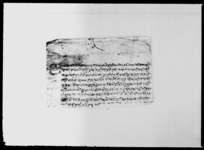A purjī from Sirtibāsa Jagāt Bhansāra to local functionaries re the operation of a copper mine in Khānīgāũ (VS 1957)
ID: E_3446_0035
Edited and
translated by Rajendra Shakya
in collaboration with
Rabi Acharya and Rajan Khatiwoda
Created: 2019-04-17;
Last modified: 2020-10-20
For the metadata of the document, click here
The accompanying edition, translation/synopsis and/or commentary are available under the terms of the Creative Commons Attribution-ShareAlike 4.0 International License
Abstract
This purjī orders local functionaries in Khānīgāũ in Kutang to be present at the Sirdibāsa Jagāt Bhansāra Office within three days on a matter relating to the operation of a copper mine.Diplomatic edition
[1r]
1श्री:\[Seal with the legend: श्रीसिर्दिवास]1स्वस्तिश्रीसिर्तीवासजगात्भन्सारकसेकुतांषानीगाउइलकाभीत्रकाद्वारे2मिझारमुषियारैतीगैह्रकेपुर्जीऊप्रन्ततेस्तरफकातामाषानीवदीया
3काचलाउनालाईजगाजगाकामानीस्वुझीजाचीहाम्राहजुरमाजाहे
4रगरीवर्षको१२०००हजारधार्नीतामोदाषिलागर्नुभंन्यायसअडाका
5नाउमाभैआयाका२छापेवडापत्रवमोजींतीमिहरुकानाउमापुर्जी
6गरीपठायाकोछतसर्थसोषानीजाचदीनालाईआजका३दींभीत्रय
7सअडामाआउन्याकाम्गरलेषियावमोजींगरेनौभन्याअैनव
8मोजींभैआउन्याछसोजानीचाडोचाडोगरीआउन्याकाम्गर५७
9सालभाद्रसुदी७रोज६शुभ¯¯¯ ¯¯¯
Translation
[1r]
[Seal with the legend: Śrī Sirdivāsa]
Hail! [A purjī] issued by ŚrīSirtīvāsa1 JagātaBhansāra
A purjī to dvāres, mijhāras, mukhiyās, ryots and the like within the Khānīgāũ area of Kutang
Uprānta: A purjī has been sent in your name in accordance with a dui-chāpe baḍāpatra2 sent in the name of this aḍḍā, which states: “Give thought to [proper] persons from various places to operate the copper mine in that area in a top manner, examine [them] and inform us [of the results]. [You will need to] deliver 12,000 [text: 12000 thousand] dhārnīs of copper annually.”
Therefore, undertake the task of coming to this aḍḍā within three days from today to examine3 the said mine. There shall, in accordance with the Ain, be consequences if [you] do not follow what is written [here]. Be informed of this and undertake the task of coming as soon as possible.
Friday, the 7th of the bright fortnight of Bhādra in the [Vikrama] era year [19]57 (1900 CE). Auspiciousness.
Commentary
The Transit Customs Office in Sirdibāsa orders, through this purjī, the local functionaries to be present at the office in three days’ time about a matter relating to the operation of a copper mine in Khānīgāũ in Kutang. Not much can be gleaned from the document regarding the manner in which the mine was supposed to come into operation, as work was still in its initial phase. The Sirdibāsa office was instructed to recruit workers, called āgaris (Turner 1931: 32), to do the mining and was set the daunting target of 12,000 dharnis of copper a year. Usually the exploitation of mines was carried out in one of two ways: 1) a person was granted an ijārā contract to operate mines upon pledging to deliver a certain amount of copper, iron, etc. per year; or 2) the mine was operated by salaried employees under the amānata system.
A regulation was promulgated on the 7th of the bright fortnight of Vaiśākha in VS 1892 (1835 CE), prescribing the functions of an ijārādāra when operating copper mines. The regulation authorized, among other things, ijārādāras to confiscate smuggled copper and punish the offender, to punish workers who mixed impurities in with the copper and to purchase copper from traders at a reasonable price arrived at by mutual consent and affix their seal to the (bundles of?) copper, and it ordered them to supply the stipulated quality of copper to the palace through hulāka porters. The regulation also warned ijārādāras not to abuse their monopoly to harass traders and mine-workers (Regmi 1975: 159–160).

